MITSUBISHI GRANDIS 2008 Owner's Manual (in English)
Manufacturer: MITSUBISHI, Model Year: 2008, Model line: GRANDIS, Model: MITSUBISHI GRANDIS 2008Pages: 458, PDF Size: 18.52 MB
Page 361 of 458
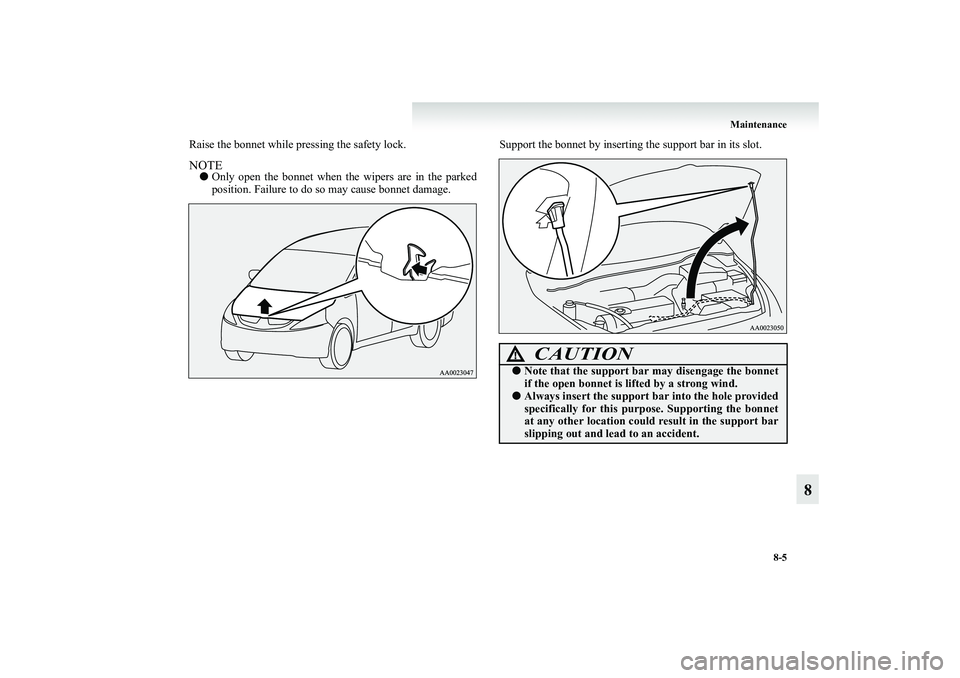
Maintenance
8-5
8
Raise the bonnet while pressing the safety lock.NOTE●Only open the bonnet when the wipers are in the parked
position. Failure to do so may cause bonnet damage.Support the bonnet by inserting the support bar in its slot.
CAUTION
!●Note that the support bar may disengage the bonnet
if the open bonnet is lifted by a strong wind.●Always insert the support bar into the hole provided
specifically for this purpose. Supporting the bonnet
at any other location could result in the support bar
slipping out and lead to an accident.
BK-XP08E1ENUK.en-uk.book Page 5 Monday, August 13, 2007 2:20 PM
Page 362 of 458
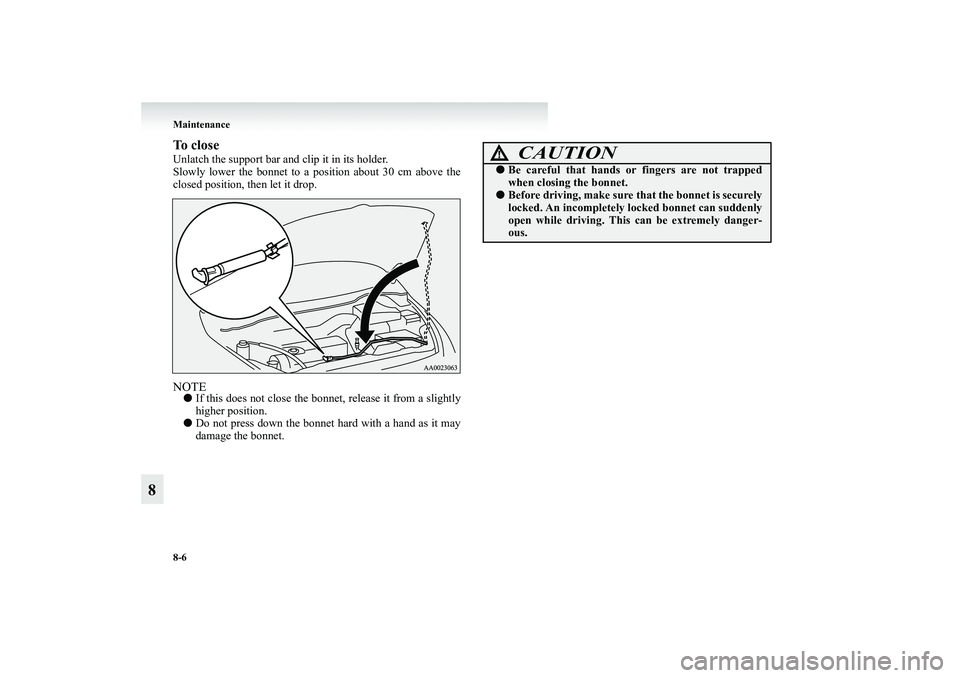
8-6 Maintenance
8
To close Unlatch the support bar and clip it in its holder.
Slowly lower the bonnet to a position about 30 cm above the
closed position, then let it drop.NOTE●If this does not close the bonnet, release it from a slightly
higher position.
●Do not press down the bonnet hard with a hand as it may
damage the bonnet.
CAUTION
!●Be careful that hands or fingers are not trapped
when closing the bonnet.●Before driving, make sure that the bonnet is securely
locked. An incompletely locked bonnet can suddenly
open while driving. This can be extremely danger-
ous.
BK-XP08E1ENUK.en-uk.book Page 6 Monday, August 13, 2007 2:20 PM
Page 363 of 458
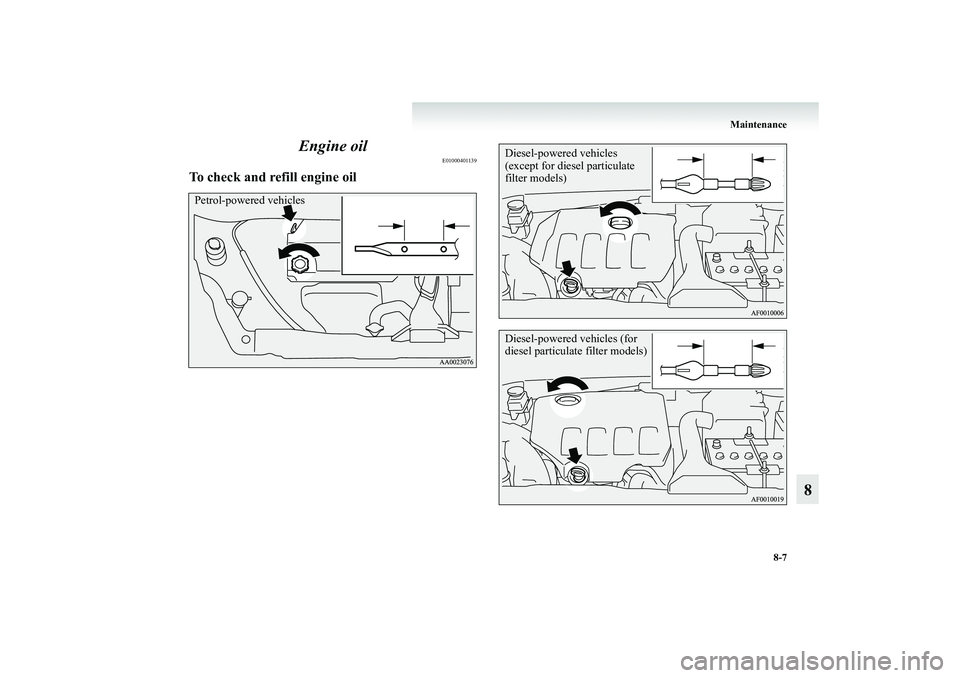
Maintenance
8-7
8 Engine oil
E01000401139
To check and refill engine oilPetrol-powered vehicles
Diesel-powered vehicles
(except for diesel particulate
filter models)Diesel-powered vehicles (for
diesel particulate filter models)
BK-XP08E1ENUK.en-uk.book Page 7 Monday, August 13, 2007 2:20 PM
Page 364 of 458
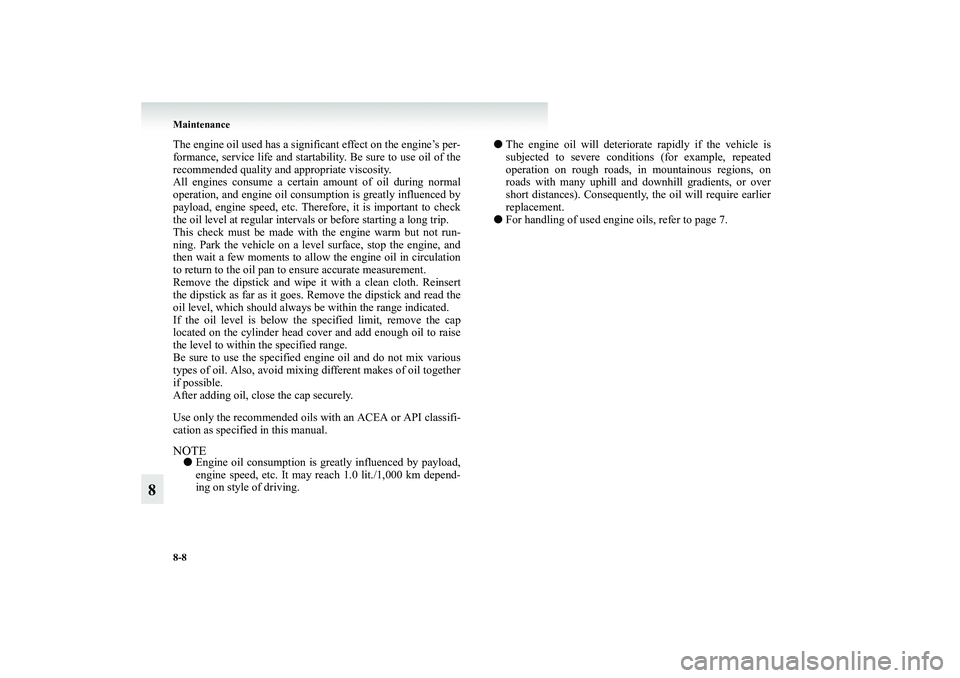
8-8 Maintenance
8
The engine oil used has a significant effect on the engine’s per-
formance, service life and startability. Be sure to use oil of the
recommended quality and appropriate viscosity.
All engines consume a certain amount of oil during normal
operation, and engine oil consumption is greatly influenced by
payload, engine speed, etc. Therefore, it is important to check
the oil level at regular intervals or before starting a long trip.
This check must be made with the engine warm but not run-
ning. Park the vehicle on a level surface, stop the engine, and
then wait a few moments to allow the engine oil in circulation
to return to the oil pan to ensure accurate measurement.
Remove the dipstick and wipe it with a clean cloth. Reinsert
the dipstick as far as it goes. Remove the dipstick and read the
oil level, which should always be within the range indicated.
If the oil level is below the specified limit, remove the cap
located on the cylinder head cover and add enough oil to raise
the level to within the specified range.
Be sure to use the specified engine oil and do not mix various
types of oil. Also, avoid mixing different makes of oil together
if possible.
After adding oil, close the cap securely.
Use only the recommended oils with an ACEA or API classifi-
cation as specified in this manual.NOTE●Engine oil consumption is greatly influenced by payload,
engine speed, etc. It may reach 1.0 lit./1,000 km depend-
ing on style of driving.●The engine oil will deteriorate rapidly if the vehicle is
subjected to severe conditions (for example, repeated
operation on rough roads, in mountainous regions, on
roads with many uphill and downhill gradients, or over
short distances). Consequently, the oil will require earlier
replacement.
●For handling of used engine oils, refer to page 7.
BK-XP08E1ENUK.en-uk.book Page 8 Monday, August 13, 2007 2:20 PM
Page 365 of 458
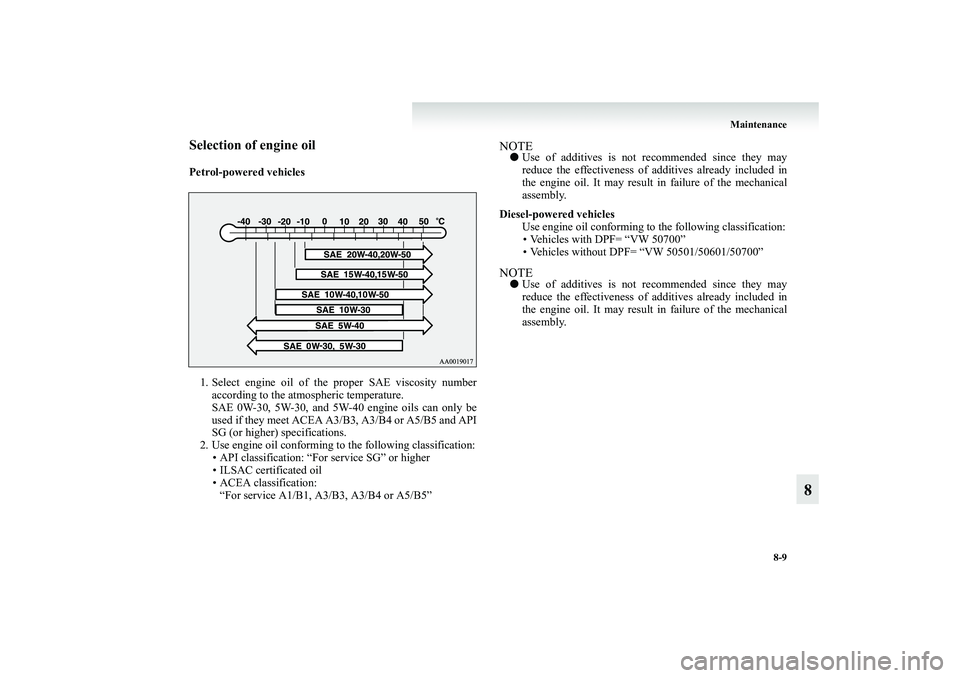
Maintenance
8-9
8
Selection of engine oilPetrol-powered vehicles
1. Select engine oil of the proper SAE viscosity number
according to the atmospheric temperature.
SAE 0W-30, 5W-30, and 5W-40 engine oils can only be
used if they meet ACEA A3/B3, A3/B4 or A5/B5 and API
SG (or higher) specifications.
2. Use engine oil conforming to the following classification:
• API classification: “For service SG” or higher
• ILSAC certificated oil
• ACEA classification:
“For service A1/B1, A3/B3, A3/B4 or A5/B5”
NOTE●Use of additives is not recommended since they may
reduce the effectiveness of additives already included in
the engine oil. It may result in failure of the mechanical
assembly.
Diesel-powered vehicles
Use engine oil conforming to the following classification:
• Vehicles with DPF= “VW 50700”
• Vehicles without DPF= “VW 50501/50601/50700”NOTE●Use of additives is not recommended since they may
reduce the effectiveness of additives already included in
the engine oil. It may result in failure of the mechanical
assembly.
BK-XP08E1ENUK.en-uk.book Page 9 Monday, August 13, 2007 2:20 PM
Page 366 of 458
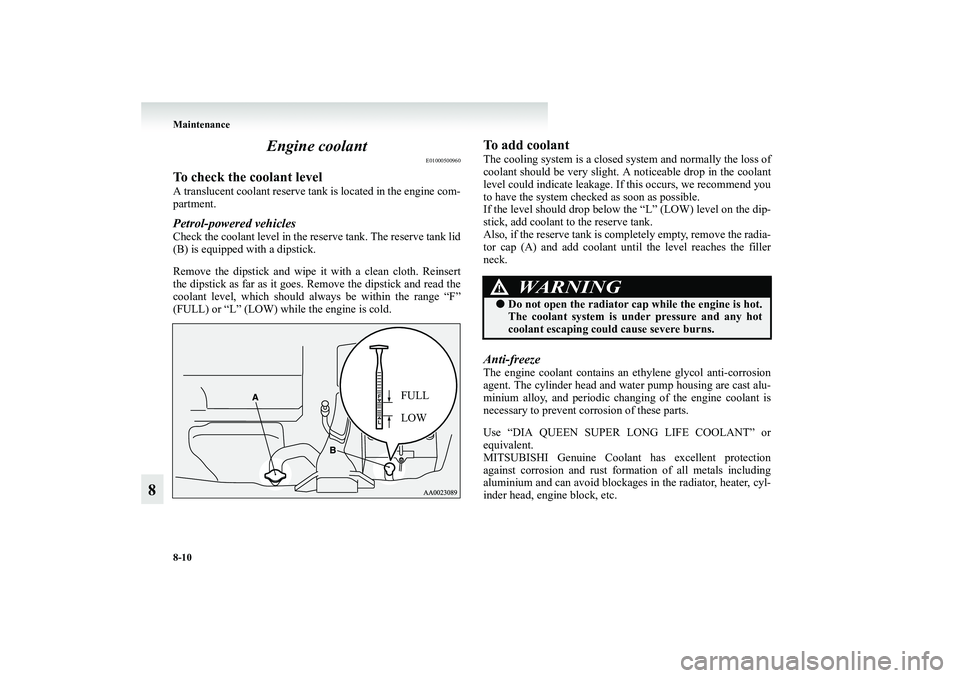
8-10 Maintenance
8Engine coolant
E01000500960
To check the coolant levelA translucent coolant reserve tank is located in the engine com-
partment.Petrol-powered vehiclesCheck the coolant level in the reserve tank. The reserve tank lid
(B) is equipped with a dipstick.
Remove the dipstick and wipe it with a clean cloth. Reinsert
the dipstick as far as it goes. Remove the dipstick and read the
coolant level, which should always be within the range “F”
(FULL) or “L” (LOW) while the engine is cold.
To add coolantThe cooling system is a closed system and normally the loss of
coolant should be very slight. A noticeable drop in the coolant
level could indicate leakage. If this occurs, we recommend you
to have the system checked as soon as possible.
If the level should drop below the “L” (LOW) level on the dip-
stick, add coolant to the reserve tank.
Also, if the reserve tank is completely empty, remove the radia-
tor cap (A) and add coolant until the level reaches the filler
neck.Anti-freezeThe engine coolant contains an ethylene glycol anti-corrosion
agent. The cylinder head and water pump housing are cast alu-
minium alloy, and periodic changing of the engine coolant is
necessary to prevent corrosion of these parts.
Use “DIA QUEEN SUPER LONG LIFE COOLANT” or
equivalent.
MITSUBISHI Genuine Coolant has excellent protection
against corrosion and rust formation of all metals including
aluminium and can avoid blockages in the radiator, heater, cyl-
inder head, engine block, etc.
FULL
LOW
WARNING
!●Do not open the radiator cap while the engine is hot.
The coolant system is under pressure and any hot
coolant escaping could cause severe burns.
BK-XP08E1ENUK.en-uk.book Page 10 Monday, August 13, 2007 2:20 PM
Page 367 of 458
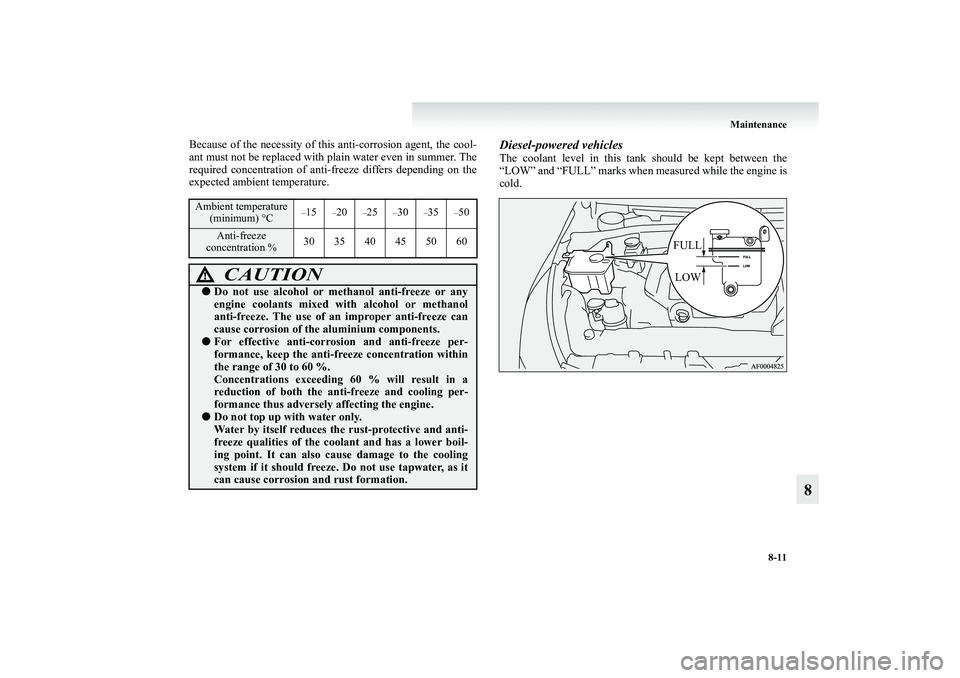
Maintenance
8-11
8
Because of the necessity of this anti-corrosion agent, the cool-
ant must not be replaced with plain water even in summer. The
required concentration of anti-freeze differs depending on the
expected ambient temperature.
Diesel-powered vehiclesThe coolant level in this tank should be kept between the
“LOW” and “FULL” marks when measured while the engine is
cold.
Ambient temperature
(minimum) °C
–15
–20
–25
–30
–35
–50
Anti-freeze
concentration %30 35 40 45 50 60CAUTION
!●Do not use alcohol or methanol anti-freeze or any
engine coolants mixed with alcohol or methanol
anti-freeze. The use of an improper anti-freeze can
cause corrosion of the aluminium components.●For effective anti-corrosion and anti-freeze per-
formance, keep the anti-freeze concentration within
the range of 30 to 60 %.
Concentrations exceeding 60 % will result in a
reduction of both the anti-freeze and cooling per-
formance thus adversely affecting the engine.●Do not top up with water only.
Water by itself reduces the rust-protective and anti-
freeze qualities of the coolant and has a lower boil-
ing point. It can also cause damage to the cooling
system if it should freeze. Do not use tapwater, as it
can cause corrosion and rust formation.
FULL
LOW
BK-XP08E1ENUK.en-uk.book Page 11 Monday, August 13, 2007 2:20 PM
Page 368 of 458
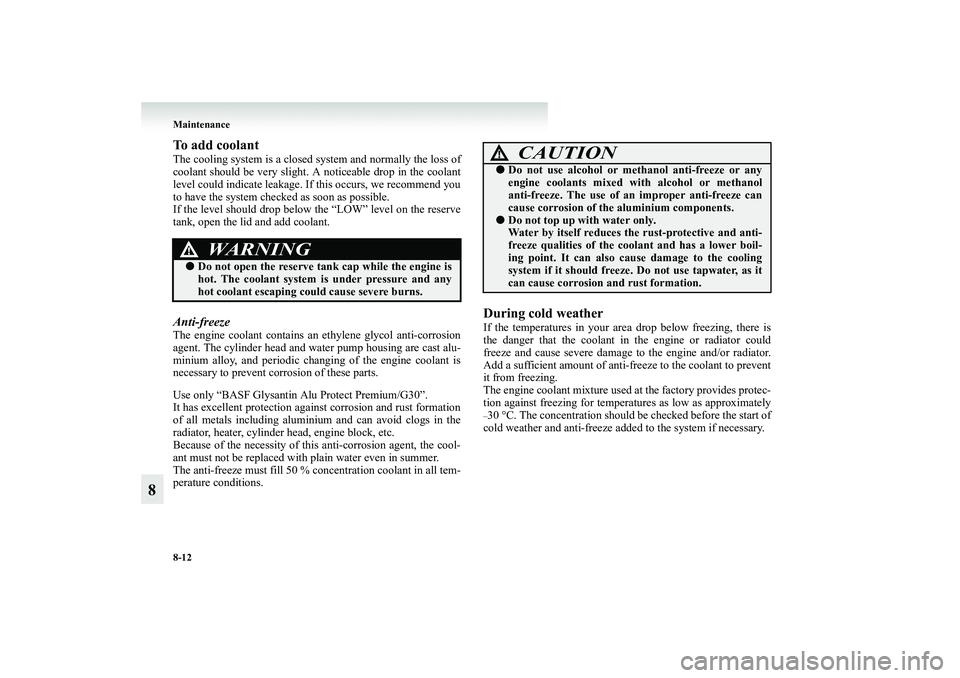
8-12 Maintenance
8
To add coolantThe cooling system is a closed system and normally the loss of
coolant should be very slight. A noticeable drop in the coolant
level could indicate leakage. If this occurs, we recommend you
to have the system checked as soon as possible.
If the level should drop below the “LOW” level on the reserve
tank, open the lid and add coolant.Anti-freezeThe engine coolant contains an ethylene glycol anti-corrosion
agent. The cylinder head and water pump housing are cast alu-
minium alloy, and periodic changing of the engine coolant is
necessary to prevent corrosion of these parts.
Use only “BASF Glysantin Alu Protect Premium/G30”.
It has excellent protection against corrosion and rust formation
of all metals including aluminium and can avoid clogs in the
radiator, heater, cylinder head, engine block, etc.
Because of the necessity of this anti-corrosion agent, the cool-
ant must not be replaced with plain water even in summer.
The anti-freeze must fill 50 % concentration coolant in all tem-
perature conditions.
During cold weatherIf the temperatures in your area drop below freezing, there is
the danger that the coolant in the engine or radiator could
freeze and cause severe damage to the engine and/or radiator.
Add a sufficient amount of anti-freeze to the coolant to prevent
it from freezing.
The engine coolant mixture used at the factory provides protec-
tion against freezing for temperatures as low as approximately–30 °C. The concentration should be checked before the start of
cold weather and anti-freeze added to the system if necessary.
WARNING
!●Do not open the reserve tank cap while the engine is
hot. The coolant system is under pressure and any
hot coolant escaping could cause severe burns.
CAUTION
!●Do not use alcohol or methanol anti-freeze or any
engine coolants mixed with alcohol or methanol
anti-freeze. The use of an improper anti-freeze can
cause corrosion of the aluminium components.●Do not top up with water only.
Water by itself reduces the rust-protective and anti-
freeze qualities of the coolant and has a lower boil-
ing point. It can also cause damage to the cooling
system if it should freeze. Do not use tapwater, as it
can cause corrosion and rust formation.
BK-XP08E1ENUK.en-uk.book Page 12 Monday, August 13, 2007 2:20 PM
Page 369 of 458
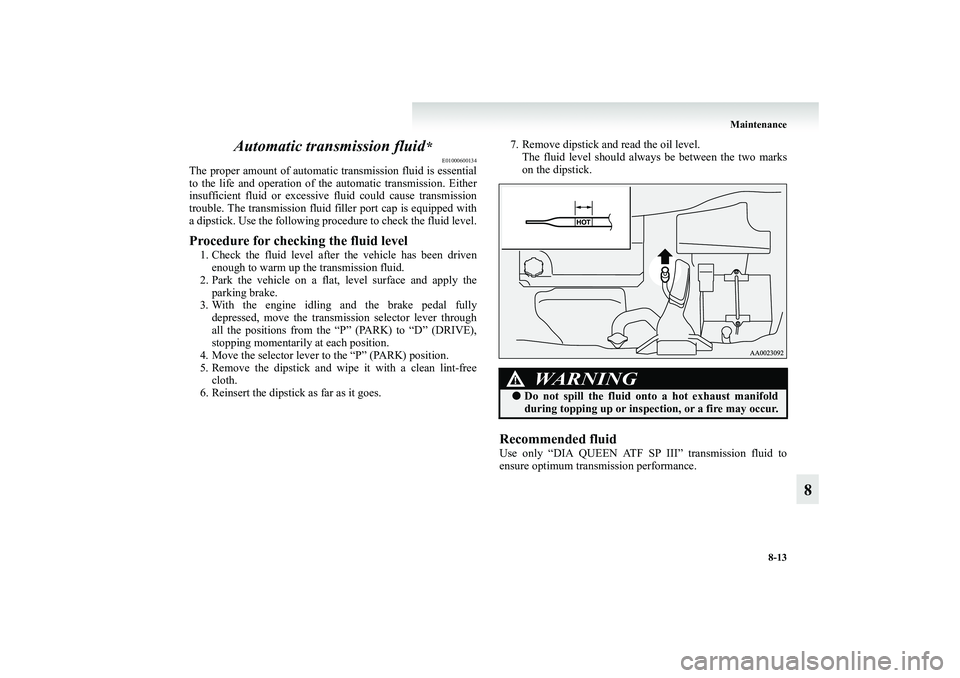
Maintenance
8-13
8 Automatic transmission fluid
*
E01000600134
The proper amount of automatic transmission fluid is essential
to the life and operation of the automatic transmission. Either
insufficient fluid or excessive fluid could cause transmission
trouble. The transmission fluid filler port cap is equipped with
a dipstick. Use the following procedure to check the fluid level.Procedure for checking the fluid level 1. Check the fluid level after the vehicle has been driven
enough to warm up the transmission fluid.
2. Park the vehicle on a flat, level surface and apply the
parking brake.
3. With the engine idling and the brake pedal fully
depressed, move the transmission selector lever through
all the positions from the “P” (PARK) to “D” (DRIVE),
stopping momentarily at each position.
4. Move the selector lever to the “P” (PARK) position.
5. Remove the dipstick and wipe it with a clean lint-free
cloth.
6. Reinsert the dipstick as far as it goes.7. Remove dipstick and read the oil level.
The fluid level should always be between the two marks
on the dipstick.
Recommended fluidUse only “DIA QUEEN ATF SP III” transmission fluid to
ensure optimum transmission performance.
WARNING
!●Do not spill the fluid onto a hot exhaust manifold
during topping up or inspection, or a fire may occur.
BK-XP08E1ENUK.en-uk.book Page 13 Monday, August 13, 2007 2:20 PM
Page 370 of 458
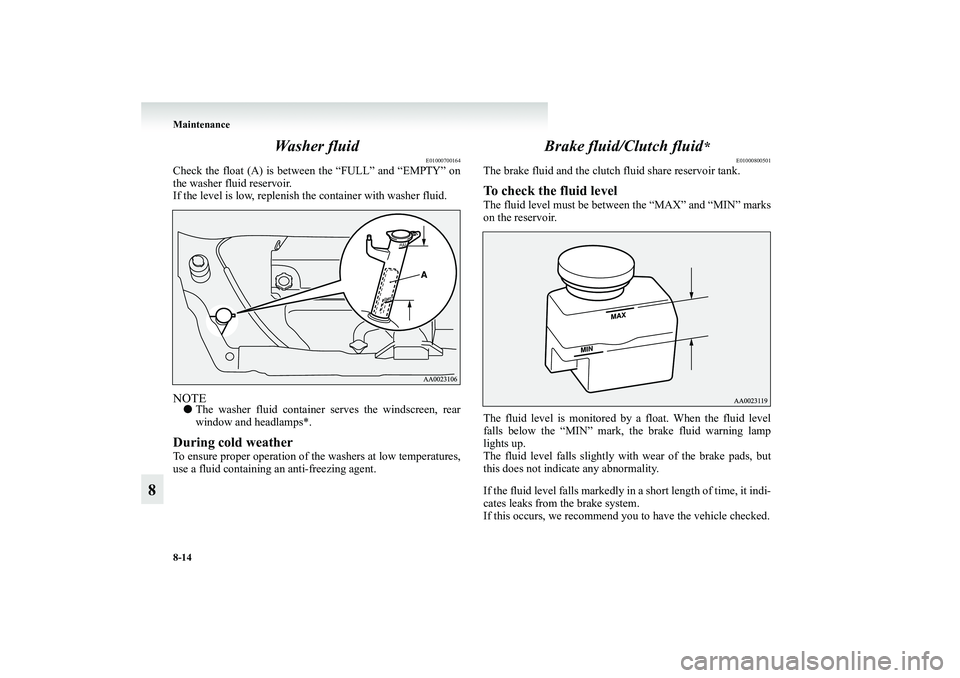
8-14 Maintenance
8Wa s h e r f l u i d
E01000700164
Check the float (A) is between the “FULL” and “EMPTY” on
the washer fluid reservoir.
If the level is low, replenish the container with washer fluid.NOTE●The washer fluid container serves the windscreen, rear
window and headlamps*.During cold weather To ensure proper operation of the washers at low temperatures,
use a fluid containing an anti-freezing agent.
Brake fluid/Clutch fluid
*
E01000800501
The brake fluid and the clutch fluid share reservoir tank.To check the fluid levelThe fluid level must be between the “MAX” and “MIN” marks
on the reservoir.
The fluid level is monitored by a float. When the fluid level
falls below the “MIN” mark, the brake fluid warning lamp
lights up.
The fluid level falls slightly with wear of the brake pads, but
this does not indicate any abnormality.
If the fluid level falls markedly in a short length of time, it indi-
cates leaks from the brake system.
If this occurs, we recommend you to have the vehicle checked.
BK-XP08E1ENUK.en-uk.book Page 14 Monday, August 13, 2007 2:20 PM